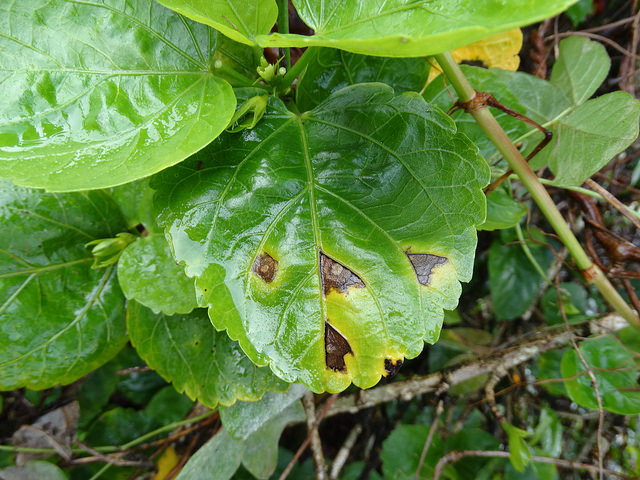This is the third part of a series on summer tree diseases. This article examines bacterial leaf spot, and bacterial wetwood.
Introduction
During the summer months, plants are in the midst of their development. While many plants flourish due to the warmer climate, others can be subject to infections from a slew of disease pathogens. The following describes some of the most common diseases to affect plants in summer, and how they impact their hosts.
Bacterial Leaf Spot (Pseudomonas spp. and Xanthomonas spp.)
Bacterial leaf spot is a disease that affects various crops and ornamental plants. It is most often caused by the bacterial pathogens Pseudomonas spp. and Xanthomonas spp. The infectious pathogens dwell on the foliage of susceptible plants. They invade plants through leaf and bark wounds, as well as through openings that have been created due to pruning. Infected plants will develop leaf spots, which discolor and kill leaves. The disease is most prevalent on older leaves, but when conditions are favorable, it can also infect new growth. Bacterial leaf spot is highly contagious. Warm, moist conditions can cause clusters of vulnerable plants to be readily infected within a few hours.
Hosts
Bacterial leaf spot infects a multitude of crops and ornamental plants. The most frequently infected crops include beets, eggplant, kale, lettuce, peppers, and tomatoes. Ornamental plants that are commonly infected include begonia, dumb cane, English ivy, ficus, geranium, hydrangea, laceleaf, philodendron, poinsettia, syngonium, and plants in the genus Prunus.
Symptoms of Infection
Symptoms of infection generally appear within 3 to 7 days. Infected plants will develop lesions, or spots, on their foliage. Lesions may form on the top or bottom portion of a leaf. The lesions are initially small, but can develop an angular shape once the infection has reached the leaf veins. As the infection advances, the lesions will gradually enlargen, growing between 3/16 and ½ of an inch in width. In some instances, a chlorotic halo may form around the spot. Several spots may coalesce, causing infected leaves to die. Some leaves will dry up in the center, and crumble away. This will cause them to assume a “shot-hole” appearance.
Infected shoots, buds, and flowers may blacken, and wither. Infected flowers will become desiccated, and break off easily. V-shaped necrotic areas may form on the leaves of begonia and geranium. On begonia, water-soaked lesions will become visible on the underside of diseased foliage. When infected, hydrangea leaves will turn a reddish-purple. Flowering plants will often wilt.
Treatment
- Avoid planting in diseased locations for at least a year.
- There are currently no recognized chemical treatments for bacterial leaf spot.
- Registered fungicides may be applied in early spring to control the disease.
- On ornamental plants, remove the affected leaves once infection symptoms become apparent. This will prevent the bacteria from spreading to healthy leaves and plants.
- Rake and dispose of fallen leaves to eliminate potential sources of bacteria.
- When planting, avoid overcrowding trees and shrubs.
- Remove plant debris from gardens to reduce the potential for overwintering bacteria.
- Prune trees and shrubs periodically to increase light penetration, and improve air circulation throughout the crown.
- Avoid mechanical injuries to susceptible plants.
- Adjust irrigation to prevent vulnerable foliage from being doused with water.
- Maintain plant vigor through sound cultural practices. Ensure that plants are sufficiently watered, especially during extended periods of drought.
- Apply a layer of organic mulch around the base of plants to improve soil quality, moderate soil temperature, and retain soil moisture.
- Avoid fertilizing plants that are suffering from bacterial leaf spot.
Bacterial Wetwood (Slime Flux)
Bacterial wetwood, often referred to as slime flux, is a bole rot that afflicts hardwood trees. The disease is associated with numerous bacteria, which infect the inner sapwood, and outer heartwood. Bacterial infection generally occurs when a tree has been wounded, or is suffering from environmental stress. Once an infection has occurred, the bacteria feeds within the inner tissue, utilizing the sap as a nutritional resource. This causes slimy, water-soaked areas to appear in the trunk, branches, and roots of infected trees. Bacterial wetwood is not fatal to trees, but it is considered a chronic disease. Persistent infection can contribute to a general decline in tree vigor over time.
Hosts
The trees that are most susceptible to bacterial wetwood include elm, apple, crabapple, London plane, redbud, aspen, dogwood, magnolia, Russian olive, beech fir, maple, sweet gum, sour gum, birch, hemlock, mountain ash, sycamore, boxelder, hickory, mulberry, butternut, horse chestnut, oak, tulip tree, cottonwood, linden, pine, black locust, poplar, willow, and walnut.
Some bacteria target specific hosts. One example is Enterobactor cloacae, which is the causal agent of bacterial wetwood in elm. Species of Clostridium, Bacillus, Klebsiella, and Psedomonas have been identified as the causal agents in various other trees.
Symptoms of Infection
The first external symptom of bacterial wetwood is a seeping or bleeding from the wounded tissue in branch crotches, pruning cuts, injection holes, and cracks in the trunk. A slimy, foul liquid is discharged from the tree, and trails down the bark, causing visible staining. Insects are attracted to the liquid, upon which they feed. When affected by bacterial wetwood, the branches of younger trees often wilt. Mature trees may experience a reduction in foliage.
Bacterial wetwood can also be observed internally. If an infected tree is removed, the heartwood will appear darker in color than the surrounding wood. Water-soaked patches that range from dark brown to black will also be identifiable in the tree’s trunk and limbs.
Treatment
- When planting, select trees that are disease resistant. Plant trees in locations where there is little urban soil compaction.
- Fertilize stressed trees to stimulate growth and mitigate the severity of the disease. Refrain from over fertilizing healthy trees, as this may increase their susceptibility to the disease.
- Remove and dispose of any dead or weakened branches, as well as any loose or diseased bark. Disinfect tools with 70% rubbing alcohol prior to pruning, and apply clean cuts around the wound to facilitate healing.
- Avoid boring holes in trees. Boring will not enhance recovery. Instead, it will create additional wounds through which disease pathogens and insects can enter.
- Avoid using draining tubes to cleanse infected areas. Drainage tubes can inadvertently transmit the disease to other sections of the tree.
- Ensure that trees are sufficiently watered, especially during periods of dry weather.
- Apply a layer of organic mulch around the base of susceptible trees. This will help improve soil quality, retain soil moisture, and moderate soil temperature.
- Avoid inflicting any mechanical injuries on trees.


